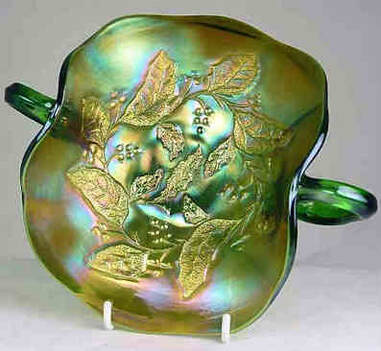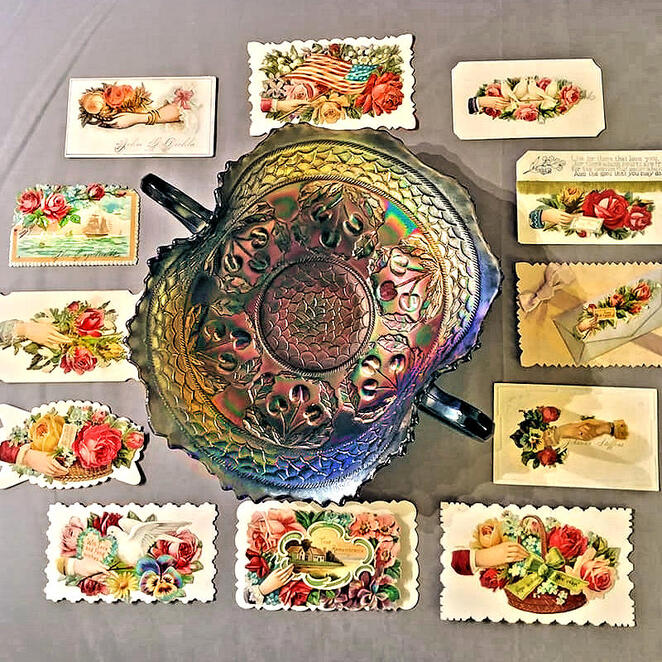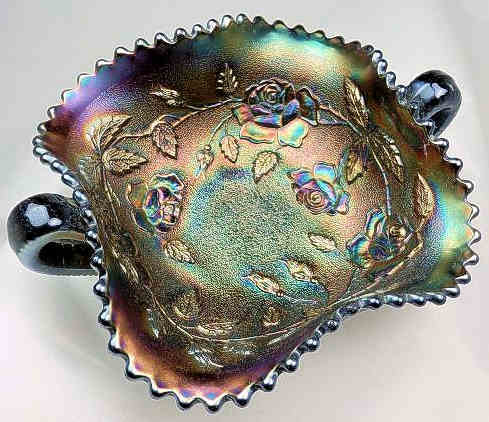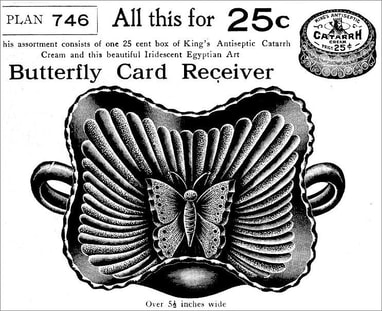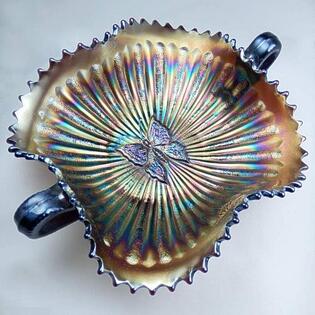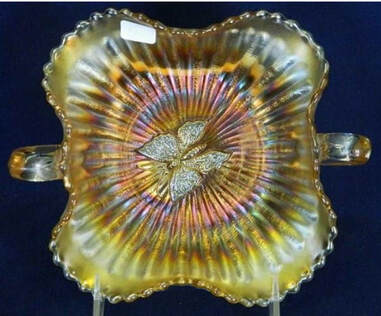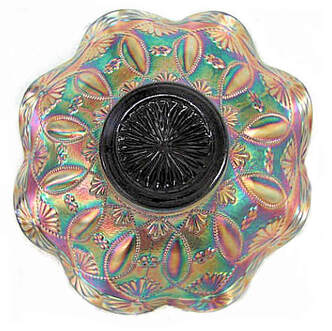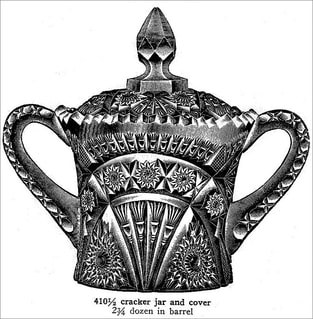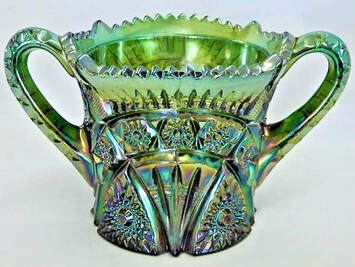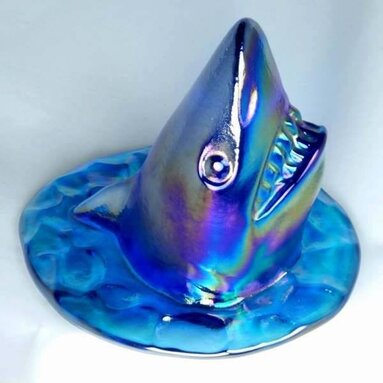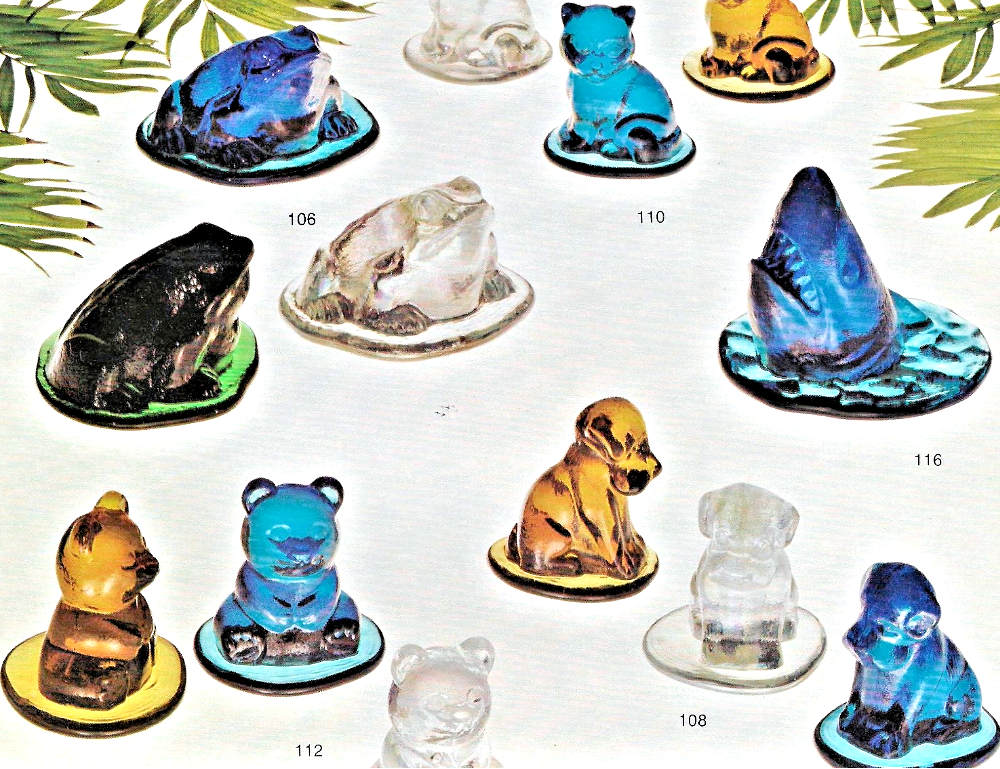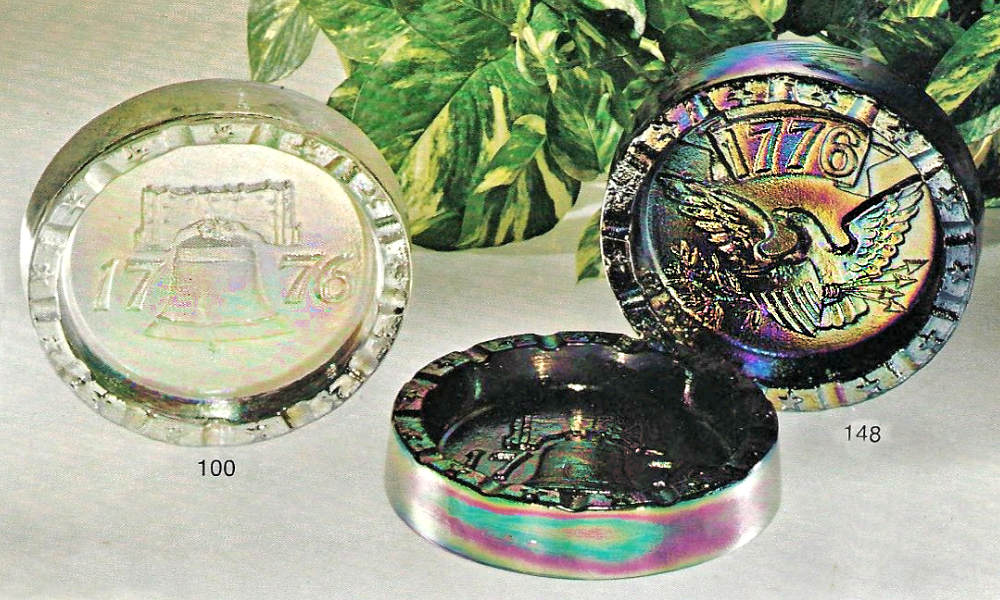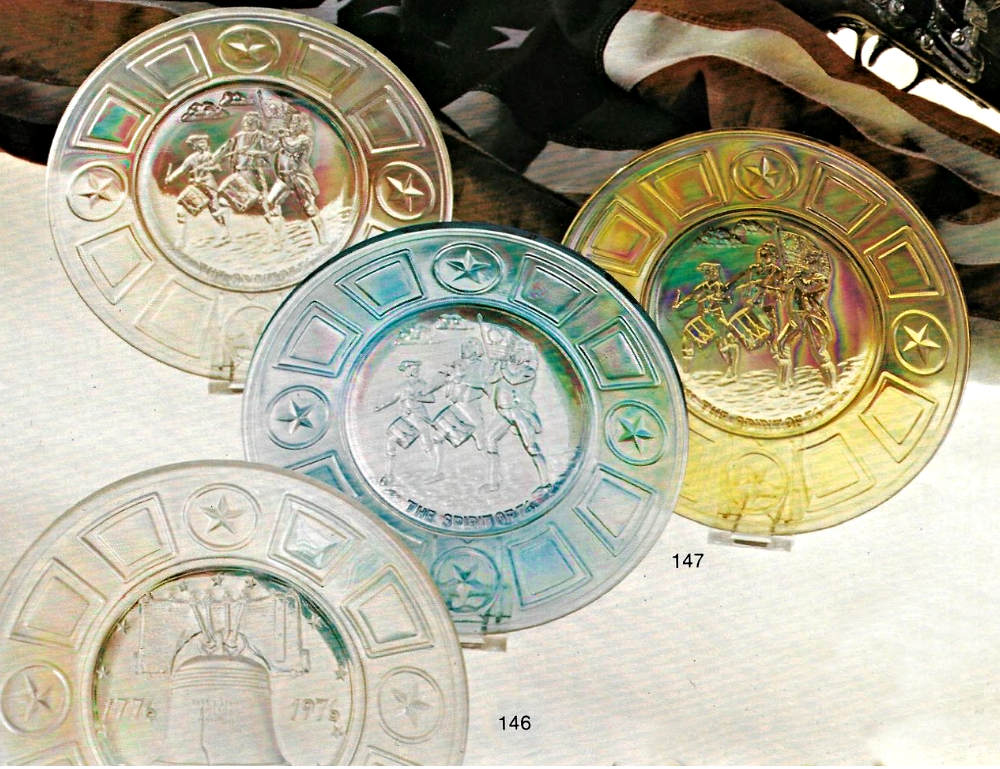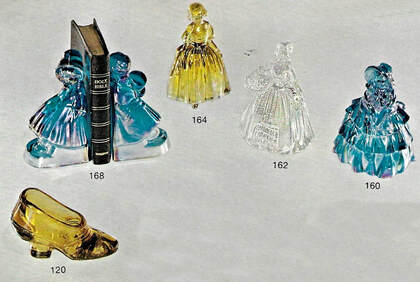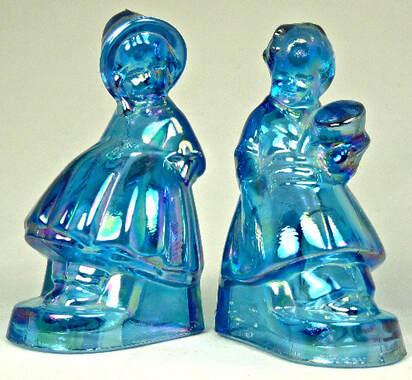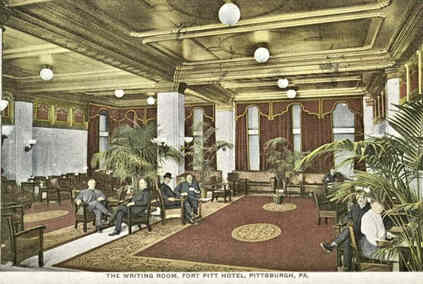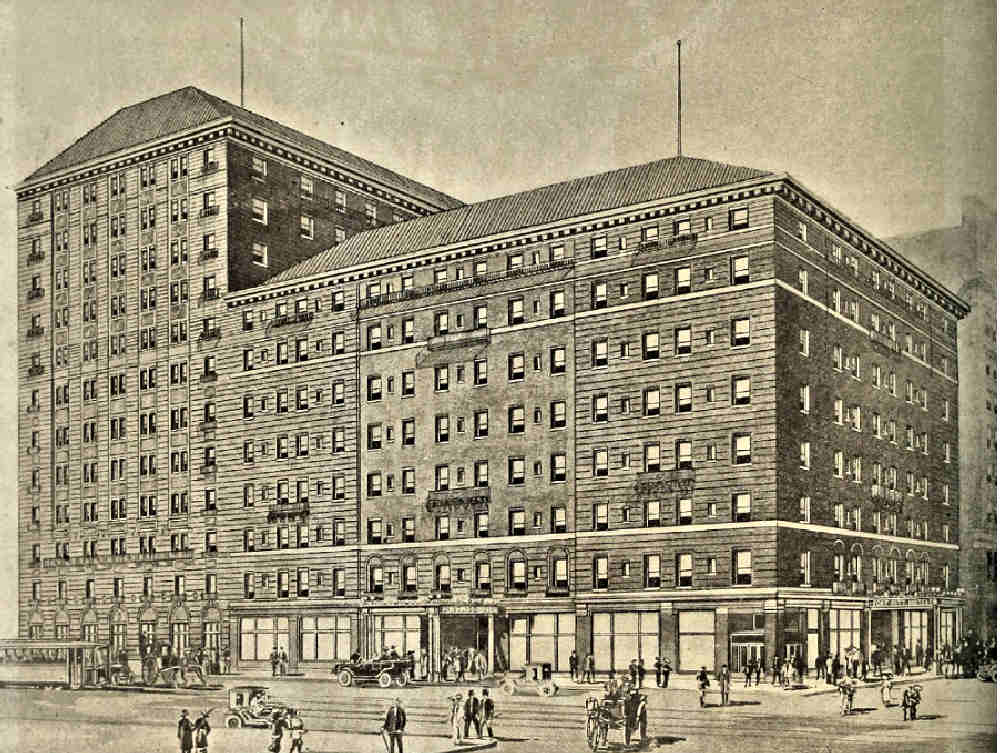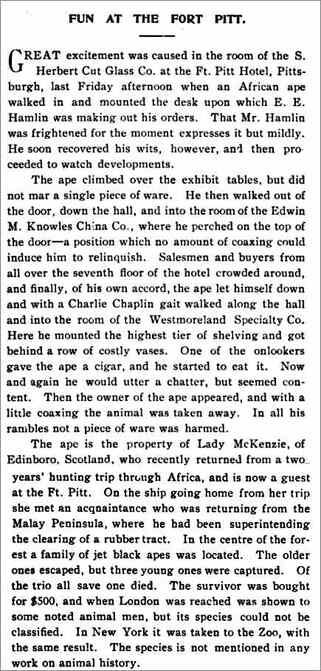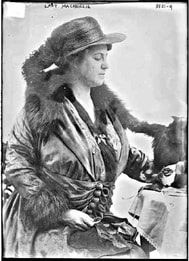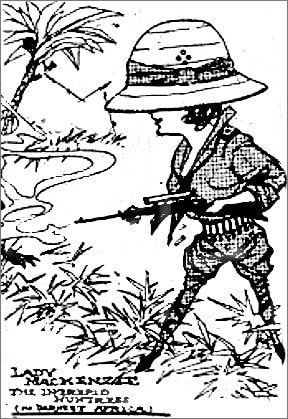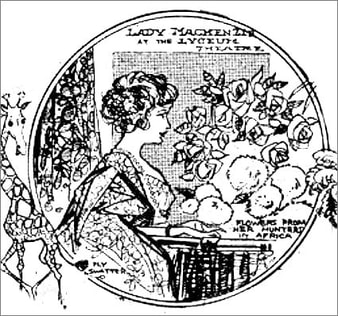NetworK ezine Issue 87. August 2022
Totally Devoted to Carnival Glass
Welcome to the August issue of Carnival Glass NetworK. We have a whole host of information in this edition – we hope you enjoy it.
Who’s Calling?
|
It does help collectors to have a framework of defined terms of reference for differently shaped pieces. Carnival collectors use the term “card tray” or “card receiver” to describe a 2-handled shape, but there can be some confusion over a similar handled shape, which is referred to as a bonbon.
The term “card tray” or “card receiver” usually refers to a 2-handled small dish, where two sides of the dish have been pulled up, making a flattened U-shape in cross section. Above: a green Millersburg Holly Whirl card tray.
|
Above: Fenton Cherry Circles card tray surrounded by calling cards.
Courtesy and thanks to Marsha Propst. |
|
The term card tray / card receiver has grown up in the Carnival collecting community over the past several decades. However, we thought it would be of interest to look back to the early 1900s when Carnival Glass was first made, and explore the original purpose, which was to hold visiting cards (calling cards). Whilst today we may simply pass on our email address to friends, many years ago, an elaborate calling card with personal details might have been handed over instead. In the amazing image at the start of this ezine we see a blue Cherry Circles card tray surrounded by a wonderful selection of authentic, old calling cards. The photo is courtesy of Marsha Propst, who explained that she was: “looking through some old family photos and found these calling cards. I believe they were used in the late 1800's to early 1900's. My paternal grandfather's name is inside one of them. It was the custom to leave one in a card tray when visiting. The card tray shown here is a cobalt blue Cherry Circles by Fenton. It was my great grandmother's and one of my favorite pieces of Carnival.” Whilst a card tray / card receiver is similar in shape to a handled bonbon, the difference is that collectors refer to a bonbon as being pulled up on all four sides. Let’s take a look at some Carnival card trays / card receivers as they were marketed a century or more ago … Card Receivers in the King Catalog No. 30 The King Manufacturing Company in St Louis operated a premium plan business, using agents to sell the goods in their catalogues. The goods would be sent to their agents by free shipping and the payments would be collected and submitted to the parent company. Agents would be compensated by receiving free goods (premiums) and/or a cash commission. We looked at some of the fascinating Carnival Glass that the company used as premiums, in two of our previous issues (you’ll find links to them at the end of this feature) – and here we have two more to share with you. We’ve stated many times in the past that the main aim of the Carnival producers and their agents, was to sell the glass. To do that, they claimed as many different kinds of use for their products as possible, and here we have two perfect examples of that. Both items below were shown in King's catalogue (c. 1909) and each was described as a card receiver. The first, the Northwood Butterfly, is in the shape we now call a handled bonbon, while the second, the Northwood Beads, is clearly what we simply refer to as a bowl. Of course, pretty much any shape could be purposed as a card receiver! And even better (for sales) if it can be presented as having several different and practical uses. It would almost be worth suffering from catarrh to purchase King’s Antiseptic Catarrh Cream in their Plan 746 and receive this beauty in “Iridescent Egyptian Art” (Carnival Glass) for 25c. |
Above: a blue stippled Basket of Roses bonbon, by Northwood.
Above is an extract from the King Catalog, No. 30 (possibly c. 1909). Courtesy Jon D Bartell and the Glass Paper Fanatics.
|
The beautiful drawing of Northwood’s Butterfly bonbon in King's Catalog (but actually described as a card receiver) shows the butterfly motif perfectly positioned between the two handles. In practice, the Northwood glassmakers did not always align the butterfly at 90 degrees to the handles. It is not unusual to find the butterfly positioned at various angles, as these two image show.
Add an extra quarter to upgrade to King’s Plan No. 487.
To relieve your catarrh and also get some King’s Liver Tablets (for “torpid liver” amongst other ailments) you would have had to cough up 50 cents.
But you surely would have had a smile on your face as you coughed and groaned, when you received your beautiful Golden Iris Card Receiver free! The item on offer was not exactly a "card receiver" - it was in fact a Northwood Beads bowl, which has an exterior design only. The colour would have been marigold (Golden Iris) but note that the ad stated that “it comes in various shapes, colors and designs” – probably signifying that King’s would send whatever pieces they had in stock.
Add an extra quarter to upgrade to King’s Plan No. 487.
To relieve your catarrh and also get some King’s Liver Tablets (for “torpid liver” amongst other ailments) you would have had to cough up 50 cents.
But you surely would have had a smile on your face as you coughed and groaned, when you received your beautiful Golden Iris Card Receiver free! The item on offer was not exactly a "card receiver" - it was in fact a Northwood Beads bowl, which has an exterior design only. The colour would have been marigold (Golden Iris) but note that the ad stated that “it comes in various shapes, colors and designs” – probably signifying that King’s would send whatever pieces they had in stock.
|
Extract from the King Catalog, No. 30 (possibly c. 1909).
Courtesy Jon D Bartell and the Glass Paper Fanatics. You can read more about the King Manufacturing Company and its catalogues in two of our past NetworK ezines, here: |
Northwood Beads (exterior pattern) bowl in green. Courtesy Burns Auctions.
|
Did You Know?
This catalogue image, below left, is undoubtedly the Forks cracker jar with a cover (lid). The image is courtesy of Kathy Conn Turner, and it comes from Imperial’s 1918 catalogue at a time we know Imperial were certainly producing Carnival (the item was also depicted in their 1909 catalogue).
This catalogue image, below left, is undoubtedly the Forks cracker jar with a cover (lid). The image is courtesy of Kathy Conn Turner, and it comes from Imperial’s 1918 catalogue at a time we know Imperial were certainly producing Carnival (the item was also depicted in their 1909 catalogue).
However, did you know that this exact shape and pattern was made both by Imperial and Cambridge?
The identical item is depicted in Cambridge catalogues as their #2696 that they called Forks. (Note, Cambridge also made a very similar cracker jar in their #2660 pattern that they called Wheatsheaf. However, it has several very clear differences in the main pattern body),
Is there a way of distinguishing between the Imperial and Cambridge versions of the Forks cracker jar? The answer is “yes”, but … it’s not that easy! Renowned Imperial researcher, Kathy Conn Turner, has noted that the difference lies in the finial (handle) on the top of the lid. According to Kathy, there are two rows of diamonds on the finial of the lid of the Cambridge Forks cracker jar, but only one row of diamonds on the lid of the Imperial version.
The problem is that currently we are not able to see any Forks cracker jar lids in Carnival Glass! Only a few in crystal are known, and we can’t be certain that the lid goes with the jar anyway (it could be a subsequent mis-match). So, for now, that’s one mystery that remains. Another mystery is why both Imperial and Cambridge made an identical cracker jar (except for that finial).
Is there a way of distinguishing between the Imperial and Cambridge versions of the Forks cracker jar? The answer is “yes”, but … it’s not that easy! Renowned Imperial researcher, Kathy Conn Turner, has noted that the difference lies in the finial (handle) on the top of the lid. According to Kathy, there are two rows of diamonds on the finial of the lid of the Cambridge Forks cracker jar, but only one row of diamonds on the lid of the Imperial version.
The problem is that currently we are not able to see any Forks cracker jar lids in Carnival Glass! Only a few in crystal are known, and we can’t be certain that the lid goes with the jar anyway (it could be a subsequent mis-match). So, for now, that’s one mystery that remains. Another mystery is why both Imperial and Cambridge made an identical cracker jar (except for that finial).
Wow! Wheatoncraft!
Seldom discussed and yet avidly collected by many, Wheatoncraft Carnival items from the 1970s include some magnificent (and quirky) items. We illustrate several of them here, and give you a comprehensive list of the shapes and the Carnival (and non-iridised) colours they were made in, courtesy of the Glass Paper Fanatics.
Seldom discussed and yet avidly collected by many, Wheatoncraft Carnival items from the 1970s include some magnificent (and quirky) items. We illustrate several of them here, and give you a comprehensive list of the shapes and the Carnival (and non-iridised) colours they were made in, courtesy of the Glass Paper Fanatics.
|
The items shown in the image above, right, are: 106 3” Frog in iridised crystal (also shown in non-iridised blue and green) 108 3” Puppy in iridised crystal (also shown in non-iridised blue and amber) |
110 3” Kitty in iridised crystal (also shown in non-iridised blue and amber) 112 3” Teddy in iridised crystal (also shown in non-iridised blue and amber) 116 Shark (“Jaws”) in iridised blue |
Also available but not shown here, were:
114 4” Turtle iridised crystal. and 104 Little 2” Frog in iridised crystal
114 4” Turtle iridised crystal. and 104 Little 2” Frog in iridised crystal
|
Wheatoncraft 1977 catalogue extracts are courtesy of Glass Paper Fanatics.
The items are, above:
100 8” Liberty Bell ashtray in iridised crystal and iridised black 148 Spirit of ’76 (Eagle) ashtray in iridised black |
146 8” Liberty Bell plate, iridised crystal, iridised blue and iridised honey amber
147 8” Spirit of ’76 plate in iridised crystal. Iridised blue and iridised honey amber were also available, but not shown here. |
|
168 5” Dutch Boy and Girl bookends in iridised blue
164 4½” Victorian Lady figurine in iridised honey amber. Iridised crystal and iridised blue were also available, but not shown here. 162 5” Colonial Lady figurine in iridised crystal. Iridised blue and iridised honey amber were also available, but not shown here. 160 5” Southern Belle figurine in iridised blue. Iridised crystal and iridised honey amber were also available, but not shown here. 120 Lady’s shoe in non-iridised amber. Iridised crystal was also available, but not shown here. |
Dutch Boy and Girl bookends in iridised blue.
|
Also offered in iridised Carnival(but not illustrated above) were 114 4” Turtle iridised crystal and 104 Little 2” Frog in iridised crystal. Other iridised items, not shown here were “pearlized” conch, scallop and snail shells and Moon & Stars comports.
Curious Happenings at the Glass Show
In the early 1900s – the years of Classic Carnival production – trade shows were popular venues for the glassmakers to demonstrate and sell their new lines. The expos (trade shows or “expositions”) held in Pittsburgh often utilised the well-known Fort Pitt Hotel, and it was there, in January 1916 at the Glass and Crockery expo, that the events took place.
In the early 1900s – the years of Classic Carnival production – trade shows were popular venues for the glassmakers to demonstrate and sell their new lines. The expos (trade shows or “expositions”) held in Pittsburgh often utilised the well-known Fort Pitt Hotel, and it was there, in January 1916 at the Glass and Crockery expo, that the events took place.
Built in 1905, the Fort Pitt Hotel had 12-storeys and several elaborate dining rooms, including the Rose Room and the Vine Room. The bedrooms were priced at $1.50 per night, with meals being extra. It was the perfect venue for the glass trade shows as it had plenty of overnight accommodation for guests as well as large public rooms to display the glass. Of course, there were other guests besides the glass and china makers and their prospective buyers – it was a very large hotel in a major city – and it was from one of the rooms of the other guests that our story sprang. Read the full account below, from the Crockery and Glass Journal in 1916, of what happened on the 7th floor of the Fort Pitt Hotel.
She was clearly a woman with two very different personas – the indomitable explorer and the society darling / film-maker. We wonder if any of her films included footage of the escaped ape admiring Westmoreland’s glassware at the 1916 Glass Expo in Pittsburgh …
Cartoon depicting the two sides of Lady Grace Mackenzie. Source “New York American” 1915, Library of Congress. No known restriction on publication (public domain).
|
Privacy and the use of your information: we only use your name and email address to send you your Carnival Glass NetworK ezine. We will not share your name or email address with anyone else, or use it for any other purpose. You can change your mind about receiving your NetworK ezine at any time by clicking the unsubscribe link at the foot of every issue, or by emailing us at [email protected]
Join us on Facebook
We invite you and your friends to join us all on NetworK's fast growing and very active Facebook Group (link is below), and if you have missed any of the previous issues of NetworK and NetworK Specials, they are all here: Back Issues.
We invite you and your friends to join us all on NetworK's fast growing and very active Facebook Group (link is below), and if you have missed any of the previous issues of NetworK and NetworK Specials, they are all here: Back Issues.

